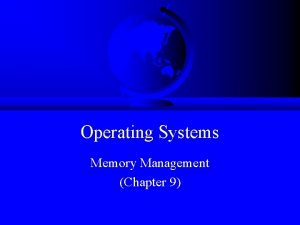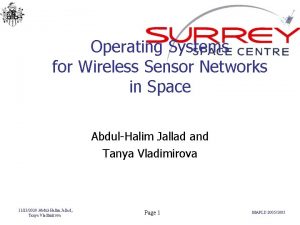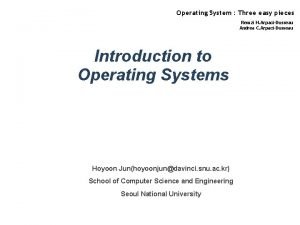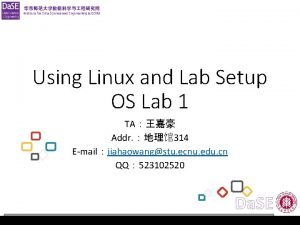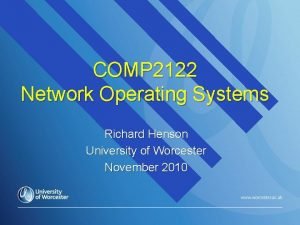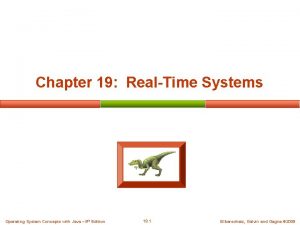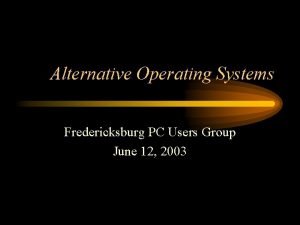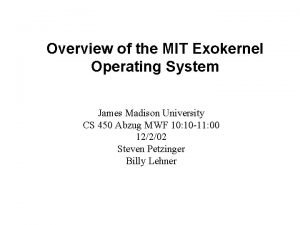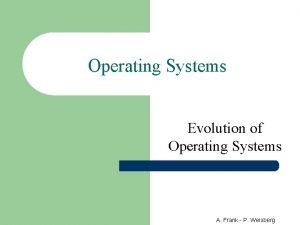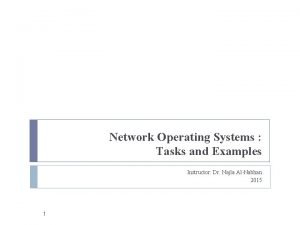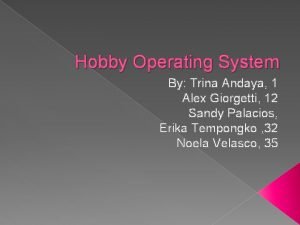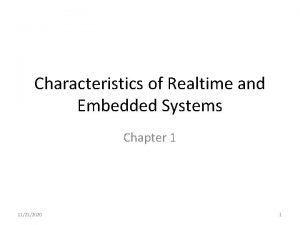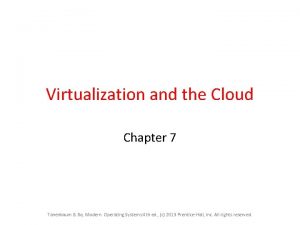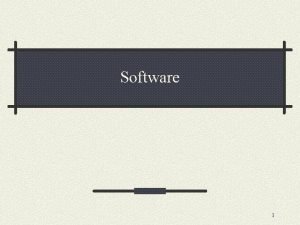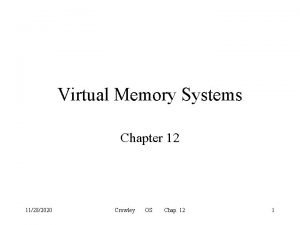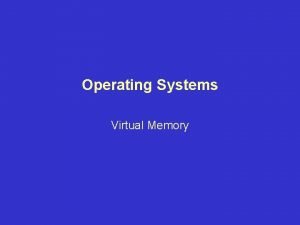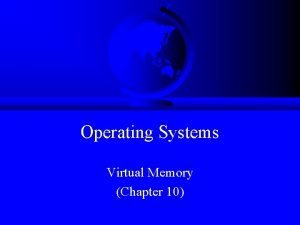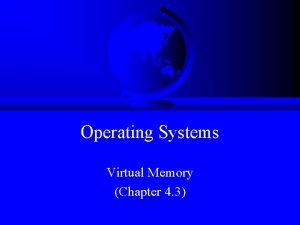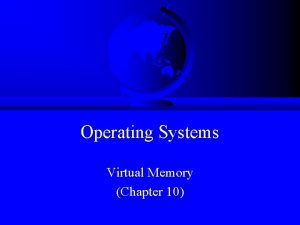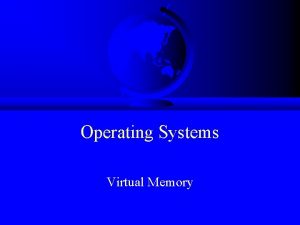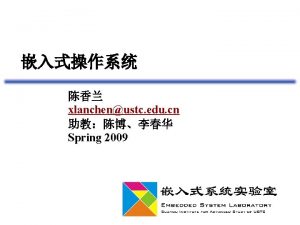Virtual Memory Chapter 9 11282020 Operating Systems Virtual







































- Slides: 39

Virtual Memory Chapter 9 11/28/2020 Operating Systems: Virtual memory 1

Objectives n To describe the benefits of a virtual memory system n To explain the concepts of: n n 11/28/2020 demand paging page-replacement algorithms allocation of page frames To discuss the principle of the working-set model Operating Systems: Virtual memory 2

Chapter Outline n n n 11/28/2020 Background Demand Paging Copy-on-Write Page Replacement Allocation of Frames Thrashing Operating Systems: Virtual memory 3

- Background n Virtual memory – separation of user logical memory from physical memory. n n n Virtual memory can be implemented via: n n 11/28/2020 Only part of the program needs to be in memory for execution Logical address space can therefore be much larger than physical address space Allows address spaces to be shared by several processes Allows for more efficient process creation Demand paging Demand segmentation (Skip) Operating Systems: Virtual memory 4

--Virtual Memory That is Larger Than Physical Memory 11/28/2020 Operating Systems: Virtual memory 5

- Demand Paging n Bring a page into memory only when it is needed n n n Page is needed reference to it n n n invalid reference abort not-in-memory bring to memory Lazy swapper – never swaps a page into memory unless page will be needed n 11/28/2020 Less I/O needed Less memory needed Faster response More users Swapper that deals with pages is a pager Operating Systems: Virtual memory 6

-- Transfer of a Paged Memory to Contiguous Disk Space 11/28/2020 Operating Systems: Virtual memory 7

-- Page Table When Some Pages Are Not in Main Memory 11/28/2020 Operating Systems: Virtual memory 8

-- Page Fault 1. Operating system looks at another table to decide: n Invalid reference abort n Just not in memory 2. Get empty frame 3. Swap page into frame 4. Reset tables 5. Set validation bit = v 6. Restart the instruction that caused the page fault 11/28/2020 Operating Systems: Virtual memory 9

-- Steps in Handling a Page Fault 11/28/2020 Operating Systems: Virtual memory 10

-- Performance of Demand Paging n Page Fault Rate 0 p 1. 0 n n n 11/28/2020 if p = 0 no page faults if p = 1, every reference is a fault Effective Access Time (EAT) EAT = (1 – p) x memory access + p (page fault overhead + swap page out + swap page in + restart overhead ) Operating Systems: Virtual memory 11

-- Demand Paging Example n Memory access time = 200 nanoseconds n Average page-fault service time = 8 milliseconds n n 11/28/2020 EAT = (1 – p) x 200 + p (8 milliseconds) = (1 – p) x 200 + p x 8, 000 = 200 + 7, 999, 800 X p If one access out of 1, 000 causes a page fault, then EAT = 8. 2 microseconds. This is a slowdown by a factor of 40!! Operating Systems: Virtual memory 12

- What happens if there is no free frame? n n Find a page in memory, but not really in use, and swap it out For better performance: n n n 11/28/2020 Find an algorithm which will result in minimum number of page faults Prevent over-allocation of memory. Use modify (dirty) bit to reduce overhead of page transfers – only modified pages are written to disk Operating Systems: Virtual memory 13

-- Basic Page Replacement 1. 2. 3. 4. 11/28/2020 Find the location of the desired page on disk Find a free frame: - If there is a free frame, use it - If there is no free frame, use a page replacement algorithm to select a victim frame Bring the desired page into the (newly) free frame; update the page and frame tables Restart the process Operating Systems: Virtual memory 14

-- Page Replacement 11/28/2020 Operating Systems: Virtual memory 15

-- Page Replacement Algorithms n n n Want lowest page-fault rate Evaluate algorithm by running it on a particular string of memory references (reference string) and computing the number of page faults on that string In all our examples, the reference string is 1, 2, 3, 4, 1, 2, 5, 1, 2, 3, 4, 5 11/28/2020 Operating Systems: Virtual memory 16

… -- Page replacement Algorithms n First-In-First-Out (FIFO) n Optimal n Least Recently Used (LRU) 11/28/2020 Operating Systems: Virtual memory 17

-- First-In-First-Out (FIFO) Algorithm n n 11/28/2020 Reference string: 1, 2, 3, 4, 1, 2, 5, 1, 2, 3, 4, 5 1 1 4 5 2 2 1 3 3 3 2 4 9 page faults 3 frames (3 pages can be in memory at a time per process) 4 frames 1 1 5 4 2 2 1 5 3 3 2 4 4 3 10 page faults Belady’s Anomaly: more frames more page faults Operating Systems: Virtual memory 18

--- FIFO Page Replacement 11/28/2020 Operating Systems: Virtual memory 19

--- FIFO Illustrating Belady’s Anomaly 11/28/2020 Operating Systems: Virtual memory 20

-- Optimal Algorithm n n Replace page that will not be used for longest period of time 4 frames example 1, 2, 3, 4, 1, 2, 5, 1, 2, 3, 4, 5 1 4 2 6 page faults 3 4 n n 11/28/2020 5 How do you know this? Used for measuring how well your algorithm performs Operating Systems: Virtual memory 21

- Optimal Page Replacement 11/28/2020 Operating Systems: Virtual memory 22

-- Least Recently Used (LRU) Algorithm … n n Reference string: 1, 2, 3, 4, 1, 2, 5, 1, 2, 3, 4, 5 1 1 5 2 2 2 3 5 5 4 4 3 3 3 Counter implementation n Every page entry has a counter; every time page is referenced through this entry, copy the clock into the counter n When a page needs to be changed, look at the counters to determine which are to change 11/28/2020 Operating Systems: Virtual memory 23

--- LRU Page Replacement 11/28/2020 Operating Systems: Virtual memory 24

-- LRU Algorithm Implementation n Stack implementation – keep a stack of page numbers in a double link form: n n 11/28/2020 Page referenced: n move it to the top n requires 6 pointers to be changed No search for replacement Operating Systems: Virtual memory 25

--- Use Of A Stack to Record The Most Recent Page References 11/28/2020 Operating Systems: Virtual memory 26

- Allocation of Frames n Each process needs minimum number of pages n Example: IBM 370 – 6 pages to handle SS MOVE instruction: n n instruction is 6 bytes, might span 2 pages to handle from 2 pages to handle to Two major allocation schemes n fixed allocation n 11/28/2020 Equal allocation Proportional allocation priority allocation Operating Systems: Virtual memory 27

-- Fixed Allocation n n 11/28/2020 Equal allocation – For example, if there are 100 frames and 5 processes, give each process 20 frames. Proportional allocation – Allocate according to the size of process Operating Systems: Virtual memory 28

-- Priority Allocation n n 11/28/2020 Use a proportional allocation scheme using priorities rather than size If process Pi generates a page fault, n select for replacement one of its frames n select for replacement a frame from a process with lower priority number Operating Systems: Virtual memory 29

-- Global vs. Local Allocation n n 11/28/2020 Global replacement – process selects a replacement frame from the set of all frames; one process can take a frame from another Local replacement – each process selects from only its own set of allocated frames Operating Systems: Virtual memory 30

- Thrashing … n If a process does not have “enough” pages, the pagefault rate is very high. This leads to: n n 11/28/2020 low CPU utilization operating system thinks that it needs to increase the degree of multiprogramming another process added to the system Thrashing a process is busy swapping pages in and out Operating Systems: Virtual memory 31

… - Thrashing 11/28/2020 Operating Systems: Virtual memory 32

-- Demand Paging and Thrashing n Why does demand paging work? Locality model n n n Process migrates from one locality to another Localities may overlap Why does thrashing occur? size of locality > total memory size 11/28/2020 Operating Systems: Virtual memory 33

-- Locality In A Memory-Reference Pattern 11/28/2020 Operating Systems: Virtual memory 34

-- Working-Set Model n n n 11/28/2020 working-set window a fixed number of page references Example: 10, 000 memory references WSSi (working set of Process Pi) = total number of pages referenced in the most recent memory references (varies in time) n if too small will not encompass entire locality n if too large will encompass several localities n if = will encompass entire program D = WSSi total demand frames if D > m Thrashing Policy if D > m, then suspend one of the processes Operating Systems: Virtual memory 35

-- Working-set model 11/28/2020 Operating Systems: Virtual memory 36

-- Keeping Track of the Working Set n Approximate with interval timer + a reference bit n Example: = 10, 000 n n Timer interrupts after every 5000 time units Keep in memory 2 bits for each page Whenever a timer interrupts copy and sets the values of all reference bits to 0 If one of the bits in memory = 1 page in working set n Why is this not completely accurate? n Improvement = 10 bits and interrupt every 1000 time units 11/28/2020 Operating Systems: Virtual memory 37

- Page-Fault Frequency Scheme n Establish “acceptable” page-fault rate n n 11/28/2020 If actual rate too low, process loses frame If actual rate too high, process gains frame Operating Systems: Virtual memory 38

End of Chapter 9 11/28/2020 Operating Systems: Virtual memory 39
 Virtual memory in operating system
Virtual memory in operating system Paged segmentation
Paged segmentation Virtual memory
Virtual memory Virtual memory in memory hierarchy consists of
Virtual memory in memory hierarchy consists of Address binding
Address binding Episodic vs semantic memory
Episodic vs semantic memory Explicit memory
Explicit memory Long term memory vs short term memory
Long term memory vs short term memory Internal memory and external memory
Internal memory and external memory Primary memory and secondary memory
Primary memory and secondary memory Physical address vs logical address
Physical address vs logical address Which memory is the actual working memory?
Which memory is the actual working memory? Eidetic memory vs iconic memory
Eidetic memory vs iconic memory Symmetric shared memory architecture
Symmetric shared memory architecture An example for operating system
An example for operating system Evolution of operating systems
Evolution of operating systems Components of operating systems
Components of operating systems What is operating system
What is operating system Wsn operating systems
Wsn operating systems Remzi arpaci-dusseau
Remzi arpaci-dusseau Operating systems lab
Operating systems lab What is dual mode in os
What is dual mode in os Andrew tanenbaum modern operating systems
Andrew tanenbaum modern operating systems File management components
File management components Design issues of distributed file system
Design issues of distributed file system Early operating systems
Early operating systems Real-time operating systems
Real-time operating systems Can we make operating systems reliable and secure
Can we make operating systems reliable and secure Alternative operating systems
Alternative operating systems Mit operating system
Mit operating system Operating system internals and design principles
Operating system internals and design principles Evolution of operating systems
Evolution of operating systems Examples of network operating systems
Examples of network operating systems Purchase msdn subscription
Purchase msdn subscription Menuet os
Menuet os Characteristics of real time embedded system
Characteristics of real time embedded system Operating systems concepts
Operating systems concepts Understanding operating system
Understanding operating system Rootkit
Rootkit Computer software is divided into
Computer software is divided into




